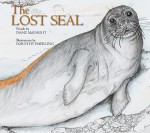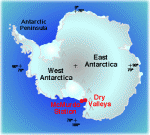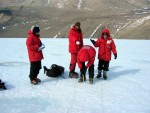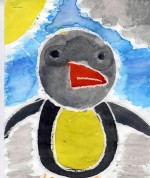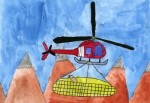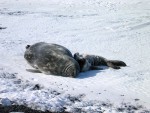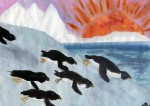New LTER book captures children's fascination with Antarctica.
A true story about an encounter between LTER scientists and a young Weddell seal in the Dry Valleys of Antarctica has inspired a new children’s book, The Lost Seal. Written by Diane McKnight, a scientist at the McMurdo Dry Valleys (MCM) LTER site and a fellow of the Institute of Arctic and Alpine Research (INSTAAR), The Lost Seal provides an engaging framework for showing how different Antarctica and the Dry Valleys are from the environments with which children are familiar. It is the second book in the National Science Foundation (NSF)-supported LTER children’s book series (the first, My Water Comes from the Mountains by Tiffany Fourment, was featured in The Network Newsletter Vol. 17 No. 2 Fall 2004).
In 1990, McKnight, who is also a professor of environmental engineering at the University of Colorado, and other limnologists (scientists who study the ecology of inland lakes and other bodies of water) were installing a network of stream gauges in Taylor Valley, Antarctica, when they came across a young seal. Although exhausted, the seal eventually made his way to the scientists’ camp, but it was clearly miles away from his natural habitat on the sea ice of McMurdo Sound. McKnight tells the story of the seal in the context of the harsh Dry Valleys environment and the LTER scientific work taking place there.
Dorothy Emerling, a well-known illustrator who worked on My Water Comes from the Mountains, also illustrated The Lost Seal with vivid scenes of the Antarctic landscape, the animals found there, and LTER scientists at work. But Emerling’s aren’t the only pictures in the book: she had plenty of help from children and their teachers from four different countries and continents. The story of the seal, videos taken at the time of the event, and photos of the Dry Valleys region were sent to forty elementary school classrooms across Australia, New Zealand, the United Kingdom, and the United States, reflecting the involvement of explorers and scientists from these countries in research in the Dry Valleys. The students created original artwork, some of which is included in The Lost Seal. All the artwork from participating children -- more than 400 pieces -- can be seen, along with the children’s own description of their work, on The Lost Seal website (www.mcmlter.org/lostseal). The site also relates illustrations from the book to real-life events and places in the Dry Valleys through maps; links; and video clips and photos of the seal, camp, and a visiting penguin.
The Lost Seal story was written originally only as a handout to use in classroom presentations. It took McKnight two years to rewrite, edit, illustrate, and publish it into a book. The book is currently in press and will be available in June 2006. Funding from the NSF supported the outreach activities involving the elementary school students, production of the book, and development of the website through the MCM’s Schoolyard LTER Program.
The Lost Seal is consistent with the science standards for 2nd to 5th grade students, for whom it was written. Its strengths include its focus on the total environment of the Dry Valleys and its thoughtful portrayal of the daily lives of scientists. McKnight observes, “Creating the book has been an exciting team effort, and we have all been inspired by the responses from the children.”
Classroom sets of The Lost Seal will be distributed to all participating schools. Moonlight Publishing, LLC (moonlight-publishing.com) is currently accepting preorders of the book which, together with My Water Comes from the Mountains, may also be ordered through Amazon and Barnes and Noble. The Georgia Coastal Ecosystem (GCE) and Hubbard Brook (HBR) LTER sites are also planning books for the series.
A workshop to discuss the children’s book series will be held during the LTER All Scientists Meeting scheduled for Estes Park, CO, from September 20-23, 2006. For more information about the book series, please contact Diane McKnight (Diane.Mcknight@colorado.edu).

 Enlarge this image
Enlarge this image